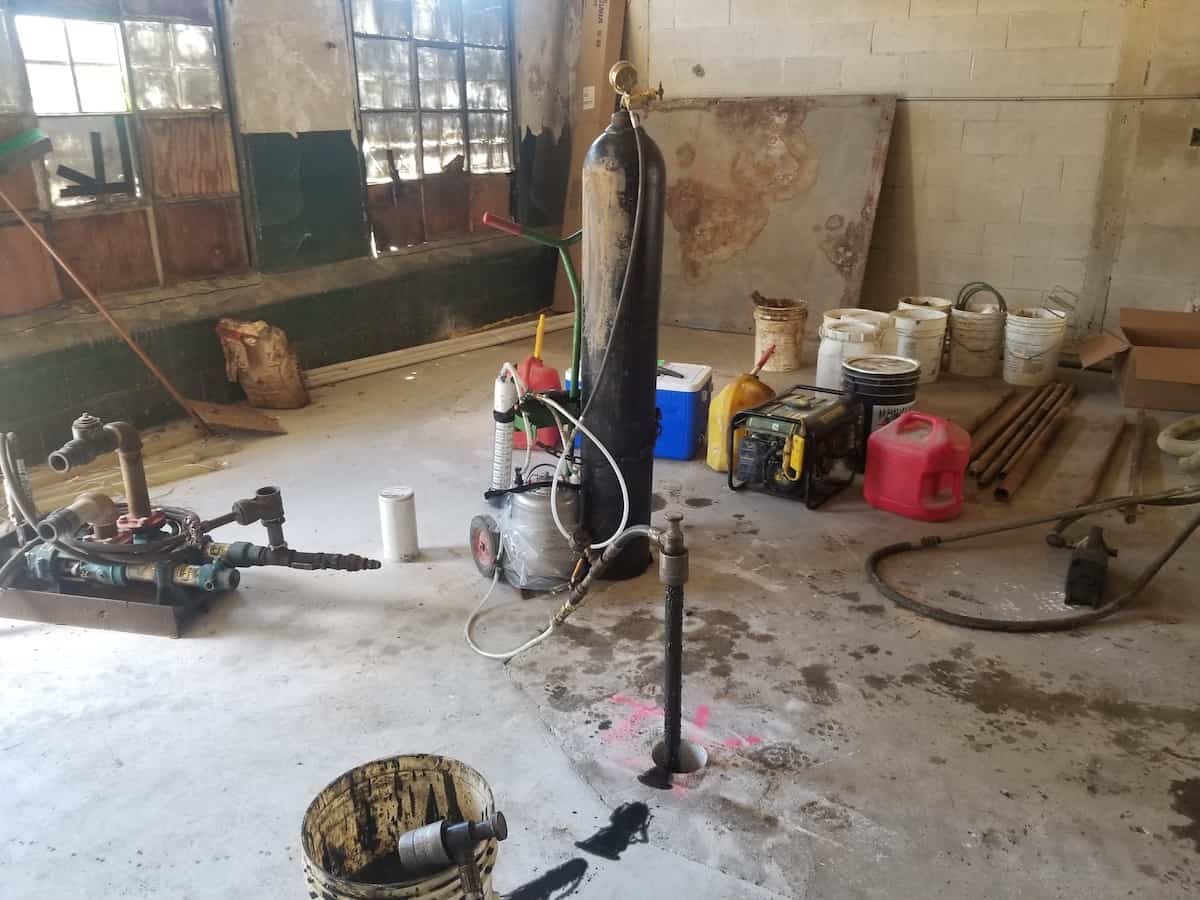How groundwater remediation ensures a safe and stable water supply
Hydrogeologist Dillon Plamann completes the vapor monitoring safety component of a groundwater remedial action injection, which was required per the injection permit to continually monitor the sub-surface for any build-up of dangerous gases that could be caused by the reaction from the injection media with the contaminated groundwater and/or soil gases.
A critical source of drinking water and irrigation, groundwater makes up about 90% of total available freshwater in the United States. When chemicals from pesticides, fertilizers, road salt, petroleum products, leaking underground storage tanks, landfill waste and other sources seep into groundwater over time, contamination occurs. Because groundwater tends to move slowly, pollution levels often remain undetected for long periods. Residents affected by contaminated groundwater can suffer severe consequences, including cholera, hepatitis, giardiasis, methemoglobinemia (blue baby syndrome), cancer and other diseases.
Remediating contaminated groundwater starts with controlling or removing the contaminant source. After eliminating the source of pollution, the contaminated groundwater can be treated in one of several ways. You can:
- Use methods such as vertical, subsurface and impermeable barriers to prevent contaminants from migrating.
- Pump the contaminated groundwater above ground and treat with a variety of methods before properly disposing or returning treated groundwater to the aquifer.
- Keep the groundwater in place and treat either the water or contaminants with commonly accepted remediation methods.
- Monitor the natural attenuation of contaminants after implementing appropriate source control.
Below, we discuss some common groundwater remediation techniques and why you need a team of experienced environmental engineers and hydrogeologists to help determine the most effective remediation strategy for your community.
Types of groundwater remediation techniques
Selecting appropriate groundwater remediation technology depends on site-specific factors, including local hydrogeological conditions, type of contaminants, soil type (permeability and porosity), area of impact and cleanup goals, among others. Combining several remediation technologies often helps achieve effective treatment. Some commonly implemented groundwater remediation techniques include:
- Air sparging. For groundwater contaminated with semivolatile organic compounds and volatile organic compounds, air sparging is often effective. The air injected – or sparged – into the aquifer creates turbulence in the contaminated groundwater zone and facilitates the volatilization of contaminants. The injected air also increases oxygen content of the groundwater leading to aerobic degradation of the contaminants.
- Pump-and-treat. This method is one of the most widely used groundwater remediation techniques. Groundwater is pumped from wells to an above-ground system to remove contaminants like dissolved chemicals, metals, fuel oils and industrial solvents. The pump-and-treat system is particularly effective at sites where it can be implemented over a long period, for example, at a large industrial facility in operation. This method gradually reduces the contaminant plume over time to prevent it from reaching wetlands, streams, drinking-water wells and other natural resources.
- Bioaugmentation/bioventing/biosparging. This method offers a short-term remedial solution where access to large equipment can be prohibitive, for example, at gas stations or dry-cleaning sites within residential neighborhoods. The efficacy, relatively low costs and adaptability to site-specific conditions make this a widely preferred remediation technique. It uses microorganisms to metabolize target organic contaminants present in land farms, biopiles, tanks and other treatment systems (ex-situ) or below ground in the soil or groundwater (in-situ).
The microbial activity can be further stimulated or enhanced by adding various amendments (biostimulation) such as air, nutrients, organic substrates, electron donors/ acceptors and other compounds. The addition of air and oxygen flow (bioventing) leads to natural in-situ biodegradation of hydrocarbon derivatives. Air is also injected under pressure (biosparging) into groundwater to increase the oxygen concentration that accelerates the biological degradation rate of contaminants.
- Carbon absorption. Similar to bioaugmentation, carbon absorption is another in-situ, short-term and cost-effective groundwater remediation technique for nondevelopment sites with limited access to large equipment. Activated carbon has a high adsorption capacity for contaminants, particularly petroleum hydrocarbons, chlorinated solvents, fertilizers and pesticides. This technique involves two contaminant removal processes — contaminant adsorption by activated carbon and degradation of contaminants through reactive chemical or biological amendments. Carbon absorption is also often used in conjunction with pump-and-treat systems.
- Ion exchange. The ion exchange remediation technique is used to treat perchlorate-contaminated groundwater on a resin bed containing functional ionic groups that capture perchlorate anions and release harmless chloride ions. The operational costs of ion exchange systems vary depending on factors like the volume of water being treated, contaminant concentration, site-specific hydrological conditions, discharge requirements and more.
- Containment. Vertical, subsurface, impermeable barriers are used to keep contaminated groundwater plumes from migrating. These vertical engineered barriers are installed below ground to control the groundwater flow and divert it before reaching wetlands, streams and drinking-water wells. Containment is a common groundwater remediation technique used at superfund sites.
- Institutional controls. Administrative and legal controls are implemented to minimize potential exposure of groundwater contaminants at redevelopment sites. Institutional controls can be extremely cost-effective because engineers can include them in the initial site design with enough planning and awareness. Some common institutional controls used at redevelopment sites include zoning restrictions, well-drilling prohibitions, easements, covenants and building and excavation permits.
- Alternative water supply. Using alternative water sources is usually more expensive than obtaining drinking water from the original source. Primarily used as a temporary solution, alternative water supplies can include delivering bottled water to surrounding communities and installing individual treatment units. If cleaning up the contaminated groundwater proves to be too challenging or expensive, community leaders may need to consider permanent alternative supplies like installing new private wells, drilling a new community water supply well or connecting to a municipal water system.
Selecting the right groundwater remediation technique depends on site-specific conditions, which only experts can determine. This is one of many reasons you should partner with a trusted team of experienced environmental engineers and hydrogeologists who can help ensure successful groundwater remediation outcomes for your community.
Why experienced environmental engineers and hydrogeologists are needed for groundwater remediation
The professionals at Fehr Graham are committed to ensuring communities across the U.S. have access to safe, reliable drinking water. Our team includes hydrogeologists, technicians and licensed operators to help you develop the best, most cost-effective solution to treat, store and distribute water. Our water engineering services go beyond developing technical solutions for groundwater remediation to include helping your community secure funding for remediation efforts.
To learn more about groundwater remediation techniques and how Fehr Graham can help you, contact us or give us a call at 920.453.0700.
 |
Dillon Plamann is a Project Hydrogeologist who helps with soil and groundwater investigations, remedial activities, due diligence and building material assessments. He also works on reports, work plans, proposals, budgets, and Phase I and II Environmental Site Assessments. Contact him at |
Collaborative, Insightful, Results-Driven Solutions
Fehr Graham provides innovative engineering and environmental solutions to help improve the lives and communities of our customers.



